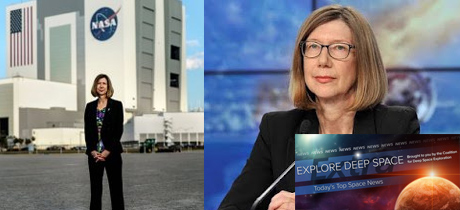In Today’s Deep Space Extra… NASA Administrator names Kathy Leuders to lead the agency’s human space exploration initiatives. The space industry demonstrates flexibility in addressing coronavirus pandemic.
Human Space Exploration
NASA selects Lueders to run human spaceflight programs
Coalition Member in the News – Boeing
SpaceNews.com (6/12): Kathy Leuders, lead for NASA’s Commercial Crew Program, was named Friday to head the agency’s Human Exploration and Operations Directorate, which is in charge of the Artemis initiative to return human explorers to the surface of the Moon by 2024. The first woman to hold the position, Leuders succeeds Doug Loverro and previously William Gerstenmaier. Ken Bowersox, who filled in following the departures of first Gerstenmaier then Loverro, resumes his previous position as deputy associate administrator of Human Exploration and Operations. Steve Stich, Leuders’ Commercial Crew Program deputy, succeeds Leuders as manager.
Yes, there’s ice on the Moon. But it’s not the 1st lunar resource we’ll use
Coalition Member in the News – Astrobotic Technologies Inc.
Space.com (6/14): NASA’s selection of Astrobotic Technologies last week to launch the VIPER ice prospecting rover to the Moon’s south pole adds enthusiasm for the presence of a vast frozen water resource that could help to advance human deep space exploration. Solar energy, however, seems sure to be first on the list of crucial lunar natural resources.
Cassidy, Behnken primed for spacewalks at month’s end
AmericaSpace.com (6/14): Thanks to a successful launch and docking of the NASA/SpaceX Demo-2 mission at the International Space Station (ISS) with U.S. astronauts Bob Behnken and Doug Hurley, Behnken is to join Station commander Chris Cassidy, also of NASA, for a series of spacewalks to complete the multi-year task of replacing aging external solar power system batteries with lighter, more efficient units. The first excursions by the two astronauts required for the task are planned for June 26 and July 1.
Space Science
Congress approves move of biological and physical sciences from HEOMD to SMD
Spacepolicyonline.com (6/12): Now authorized by Congress, the move sought by NASA leadership means supervision of the agency’s Space Biology Program and Physical Science Program will move from the Human Exploration and Operations Mission Directorate (HEOMD) to the Science Mission Directorate (SMD). The Human Research Program, focused on applied rather than fundamental research involving astronaut health, will remain in the Human Exploration Directorate.
‘Standard model’ of cosmology called into question by new measurements
Space.com (6/14): Observations led by a Harvard researcher with four ground-based telescopes have found discrepancies in the distances previously measured to four distant galaxies, calling into question the Hubble Constant, or rate predicted for the expansion rate of the universe. The findings surrounding the new higher rate were published in the Astrophysical Journal Letters.
Other News
How the space industry has adjusted to life under coronavirus
MIT Technology Review (6/10): The space industry’s adjustments to the global coronavirus pandemic have come in many forms from telework and launch delays to embracing workplace precautions. The latter enabled workers to continue to address mission essential deadlines such as preparing the Perseverance Mars rover for a July 20 liftoff and getting NASA’s Commercial Crew Program SpaceX Demo-2 mission launched and docked to the International Space Station (ISS) with a pair of NASA astronauts on May 30/31. Then there’s been the layoffs, even a bankruptcy filing.
SpaceX launches 58 Starlink satellites and 3 Planet SkySats, nails rocket landing
Space.com (6/13): A Falcon 9 rocket launched from Cape Canaveral Air Force Station, Florida, on Saturday at 5:21 a.m., EDT, with 58 Starlight internet connectivity satellites, bringing the total number of Starlight spacecraft launched to date to 540. SpaceX also provided a rideshare for the launch of three small Planet SkySat Earth imaging satellites.
Rocket Lab’s 12th launch sends satellites into space for NRO, NASA and Australia
GeekWire.com (6/12): Rocket Lab’s small satellite Electron rocket launched from New Zealand early Saturday, EDT, with three U.S. National Reconnaissance Office (NRO) payloads and a NASA satellite, Andesite. Andesite will assess the Earth’s magnetic field and track space weather. Another payload, M2 Pathfinder, will demonstrate Australian space technologies.
Spaceflight Industries completes rideshare divestiture
SpaceNews.com (6/13): Spaceflight Industries, of Herndon, Virginia, has completed the sale of its satellite rideshare business, Spaceflight Inc., of Seattle, to a Japanese joint venture, Mitsui & Co. and Yamasa Co. Spaceflight Industries retains ownership of BlackSky, a satellite Earth observation company.
Oh no no, there goes Momo
Parabolicarc.com (6/13): An attitude control system failure was blamed for the failed launch on Saturday of an Interstellar Technologies’ Momo suborbital rocket. It marked the rocket’s fourth failure.
Major Space Related Activities for the Week
Major space related activities for the week of June 14-20, 2020
Spacepolicyonline.com (6/14): NASA will host a pre-launch news briefing on the Mars 2020 Perseverance rover mission on Wednesday at 2 p.m., EDT, viewable at www.nasa.gov/live. Launch from the Cape Canaveral Air Force Station, Florida, is now planned for July 20. Various space policy making forums are planned this week with space weather, astronomy and astrophysics themes. While the U.S. Senate is in session this week, the House is meeting in committee format. Congress remains relatively quiet on the civil space front.

